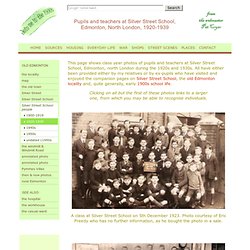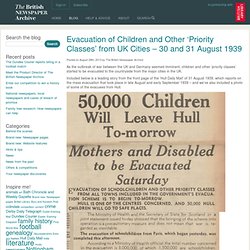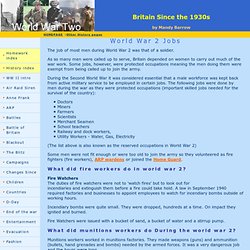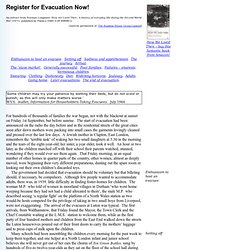

Poster 1995/537. Poster 1995/547. AMD - Secure Access Management. Pupils and teachers at Silver Street School, Edmonton, North London, 1920-1939. This page shows class year photos of pupils and teachers at Silver Street School, Edmonton, north London during the 1920s and 1930s.

All have either been provided either by my relatives or by ex-pupils who have visited and enjoyed the companion pages on Silver Street School, the old Edmonton locality and, quite generally, early 1900s school life. Clicking on all but the first of these photos links to a larger one, from which you may be able to recognise individuals. Evacuation day from Silver Street School, August 1939. The railings of Pymmes Park can be seen on the right hand side of the picture. According to Richard Cole, they were later sawn off to provide iron for the War effort. My aunt, Ena Cole, who was a former school teacher, responded to the call for women to help with the evacuation. Note that the meaning of 'infants' and 'juniors' changed since the school was built to Victorian specifications - see the labelling over the school entrance doors.
Photographs from later years →. Evacuation of Children and Other ‘Priority Classes’ from UK Cities – 30 and 31 August 1939. As the outbreak of war between the UK and Germany seemed imminent, children and other ‘priority classes’ started to be evacuated to the countryside from the major cities in the UK.

Included below is a leading story from the front page of the ‘Hull Daily Mail’ of 31 August 1939, which reports on the mass evacuation that took place in late August and early September 1939 – and we’ve also included a photo of some of the evacuees from Hull.
Home Sweet Home Front - EVACUATION. World War 2 Jobs. The job of most men during World War 2 was that of a soldier.

As so many men were called up to serve, Britain depended on women to carry out much of the war work. Some jobs, however, were protected occupations meaning the men doing them were exempt from being called up to join the army. During the Second World War it was considered essential that a male workforce was kept back from active military service to be employed in certain jobs. The following jobs were done by men during the war as they were protected occupations (important skilled jobs needed for the survival of the country): Doctors Miners Farmers Scientists Merchant Seamen School teachers Railway and dock workers, Utility Workers - Water, Gas, Electricity (The list above is also known as the reserved occupations in World War 2) Some men were not fit enough or were too old to join the army so they volunteered as fire fighters (fire workers), ARP wardens or joined the Home Guard.
Incendiary bombs were quite small. BBC Radio 2 - Operation Pied Piper. Primary History - World War 2 - Evacuation. Evacuation - World War II (1939-45) After war was declared, people expected that the Luftwaffe would bomb Britain and that civilian casualties would be enormous.

The Department of Health in Scotland spent the early months of 1939 preparing details for the evacuation of unaccompanied children, mothers with children under school age, blind people and invalids from vulnerable areas. Areas affected were Edinburgh, Rosyth, Glasgow, Clydebank, Dundee, Inverkeithing and Queensferry – and from May 1941, after the Clydeside air-raids, Greenock, Port Glasgow and Dumbarton were added. Evacuation was voluntary. Some had made private arrangements but when the order came at 11.07 on 31 August 1939 to ‘Evacuate Forthwith’, nearly 176,000 children assembled; 120,000 leaving Glasgow within three days. Children mustered at their local primary school, carrying their gas-mask, toothbrush, change of underclothes and label.
It was a logistical nightmare to process the evacuees on arrival and allocate accommodation. Longmate_evacuation. Long before Christmas 1939 the great drift homewards was well under way.

The death blow to the largest and most successful scheme, that for unaccompanied children, was inflicted by the government itself, which, as it had all along intended, began from the end of October to demand a contribution from parents to help support their evacuated children. The amounts involved were less than the official billeting allowance of 10s.6d. for one child, 8s.6d. each for more than one, for six shillings a child would, it was announced, be accepted in full settlement, but the scheme proved literally more trouble than it was worth, burdening hard-pressed officials with an enormous amount of extra work and yielding only a trivial financial return.
In innumerable cases it tipped the scale in deciding parents to bring their children home… By the 8th January 1940, 900,000 of the nearly one-and-a-half million adults and children evacuated in September I939 had gone home.